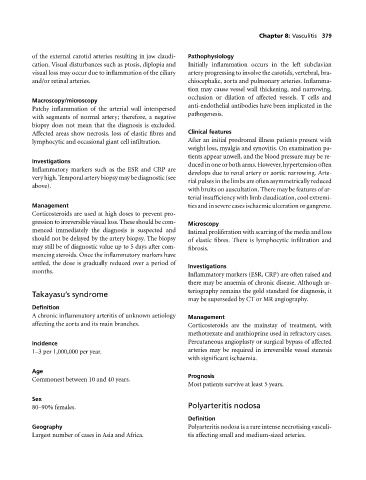Page 383 - Medicine and Surgery
P. 383
P1: KTX
BLUK007-08 BLUK007-Kendall May 12, 2005 19:48 Char Count= 0
Chapter 8: Vasculitis 379
of the external carotid arteries resulting in jaw claudi- Pathophysiology
cation. Visual disturbances such as ptosis, diplopia and Initially inflammation occurs in the left subclavian
visual loss may occur due to inflammation of the ciliary artery progressing to involve the carotids, vertebral, bra-
and/or retinal arteries. chiocephalic, aorta and pulmonary arteries. Inflamma-
tion may cause vessel wall thickening, and narrowing,
occlusion or dilation of affected vessels. T cells and
Macroscopy/microscopy
anti-endothelial antibodies have been implicated in the
Patchy inflammation of the arterial wall interspersed
pathogenesis.
with segments of normal artery; therefore, a negative
biopsy does not mean that the diagnosis is excluded.
Affected areas show necrosis, loss of elastic fibres and Clinical features
lymphocytic and occasional giant cell infiltration. Afteran initial prodromal illness patients present with
weight loss, myalgia and synovitis. On examination pa-
tients appear unwell, and the blood pressure may be re-
Investigations
duced in one or both arms. However, hypertension often
Inflammatory markers such as the ESR and CRP are
develops due to renal artery or aortic narrowing. Arte-
very high. Temporal artery biopsy may be diagnostic (see
rial pulses in the limbs are often asymmetrically reduced
above).
with bruits on auscultation. There may be features of ar-
terial insufficiency with limb claudication, cool extremi-
Management ties and in severe cases ischaemic ulceration or gangrene.
Corticosteroids are used at high doses to prevent pro-
gression to irreversible visual loss. These should be com- Microscopy
menced immediately the diagnosis is suspected and Intimal proliferation with scarring of the media and loss
should not be delayed by the artery biopsy. The biopsy of elastic fibres. There is lymphocytic infiltration and
may still be of diagnostic value up to 5 days after com- fibrosis.
mencing steroids. Once the inflammatory markers have
settled, the dose is gradually reduced over a period of
Investigations
months.
Inflammatory markers (ESR, CRP) are often raised and
there may be anaemia of chronic disease. Although ar-
teriography remains the gold standard for diagnosis, it
Takayasu’s syndrome
may be superseded by CT or MR angiography.
Definition
Achronic inflammatory arteritis of unknown aetiology Management
affecting the aorta and its main branches. Corticosteroids are the mainstay of treatment, with
methotrexate and azathioprine used in refractory cases.
Incidence Percutaneous angioplasty or surgical bypass of affected
1–3 per 1,000,000 per year. arteries may be required in irreversible vessel stenosis
with significant ischaemia.
Age
Prognosis
Commonest between 10 and 40 years.
Most patients survive at least 5 years.
Sex
80–90% females. Polyarteritis nodosa
Definition
Geography Polyarteritis nodosa is a rare intense necrotising vasculi-
Largest number of cases in Asia and Africa. tis affecting small and medium-sized arteries.

